For Project 2, Interactive fiction, I wanted to do a version of the coming of age story.
Here is the link to the download: (EDIT: It is uploaded and can be played directly on itch.io as well!)
Here is the initial brainstorming I started with and expanded on.
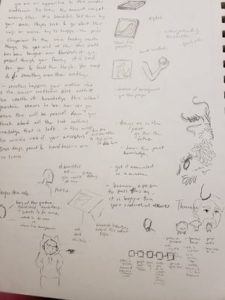
My original idea was I wanted to capture the tension of two themes: the traditional art form slowly dying out in a more digital future, and the coming of age choice to take on the family traditional business or to pursue your work. I wanted this story to be a twist where the main character actually wanted to take on the art traditions, but was discouraged by family. I liked the idea of this master craftsman being a maternal figure like a grandmother, and the main character being their granddaughter. I first fleshed out the story using the snowflake method, and had sequential events of the granddaughter spending time with her grandmother, being at school and discovering her grandmother passed away, and then coming back to her studio and having to make a decision. I quickly realized that the scope of the story was pretty broad.
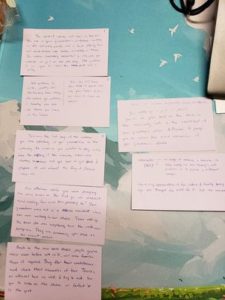
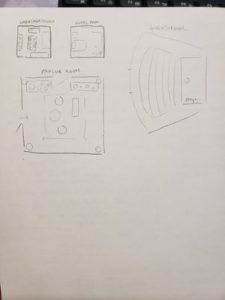
My next iteration, I tried out the structure of what if the first interaction with grandma was in a dream. This way, readers can get contextual information, and the sequence of events can be shorter. I imagined making this into a more short story format; I can condense the events and have most of the story as part of getting informed for the decision that has to be made at the end. So I started to imagine different aspects of information the character could get that could inform her decision. So I had 3 paths, which represented different perspectives the main character Jenna (aka Jeown) could get, which were selling the art, taking over the art business, and prioritizing family. In this stage, I set up the backbone of the story flow.
After fleshing that out more, I got to test this story at the Thursday Game Night, 2/10 with Goutham and Christina. People liked the premise of the story, and how the paths would inform the decision at the end. The reveal of information was good as well. I got good feedback on how to set up some choices better and build motives the main character might have in going through this. Once I had an idea of the endings of the story, I asked for feedback from my sister and best friend. They also mentioned how they liked the premise of the story. Got feedback on making the motive of the character stronger. I also started to try to work with the logic statements in Twine. I tried out if then statements with history, trying to see that if you choose a certain choice in the conversation, it will change the outcome of the decision you make. I then learned that creating variables for the different choices was the best way to do so. That took a bit of time to figure out how to create variables, and use ‘if and‘ statements. I was able to figure out the structure though! So was pretty proud in setting up the statements that can show certain dialogue if conditions are met. I also made the decision to limit the player the choice to talk to 2 people out of 3, to skew their perspective when making the decision at the end. I wanted this to reflect how sometimes you have to make a decision with whatever limited information you can have, and to encourage replayability for people to try out the different path.
I got further feedback from Rachel and Shauna from the Monday session, on how to set up the character to make the choices as well. There were proofreading errors that I needed to fix. Points were brought up that I needed to show the character’s past experience with lacquerware better so that the player knows that the main character could possibly take over the lacquerware making. And to highlight the family responsibility more prominently. I took this into account and tried to update the worldbuilding as well. I fleshed out the endings of each choice, and added specific endings if you chose the corresponding dialogue. Referenced the cat theme more by adding a subtle cat-like aspect to each path.
My sister helped me with the final playtesting. She enjoyed the updated worldbuilding that fleshed out the story for her. For someone who already knew about the story, she mentioned playing through the decision at the end wasn’t as impactful on subsequent runs, which is an insightful point.
Final story layout:
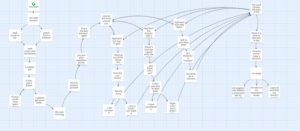
Reflection:
This interactive fiction project was a nice challenge for me. It was definitely out of my comfort zone, as I haven’t done writing for fun in so long. In the beginning, I was not even sure what I was getting myself into and whether I could do this. Now, I am happy to say that I am pretty proud of my product– it has come so far. I touched in my iterations that I wanted to do a version of a coming of age story. I also wanted to capture the tensions of an art tradition that is dying out in a more digital world, and the tension of a young adult choosing the family business or what they want to do. In the end, I was able to craft a story that showed a young adult navigating the aftermath of her grandma, a master craftsmen’s death and legacy she left behind. Hints of the art tradition and changing world are there, and the main character does go through the dilemma of picking what she thinks will be the best choice for her, her family, and her grandma’s legacy.
When I was looking up traditional art to reference from real life traditions, I realized that I wanted to connect this to my cultural heritage. I didn’t know that much about traditional burmese art, and as I was doing research, the one that caught my eye was lacquerware. The process of creating lacquerware, which could take up to 6-8 months was an intensive process, but created such beautiful vessels. I decided to reference this traditional art in my story. The names of the characters, Jeown (cat) and Thanaka (traditional makeup) are burmese words as well.
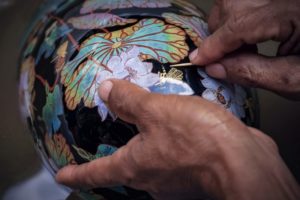 by Turquoise Mountain.
by Turquoise Mountain.
It was great to get practice in writing a story. As I built on iterations, I realized places I could flesh out more so that players can get the appropriate information. It was a bit difficult to think about how to get players enough information in the different paths so that they can have a nuanced idea of what is important to the main character. I also learned how to work with logic statements on Twine. I have a little bit of coding experience, but it has been a while. I was pretty proud of how I could set a variable and use the if and statements to change the outcome of the dialogue shown if certain choices were made. Setting variables was tricky, but once I got that, I was able to change the outcomes of the endings as well. It was small, but it felt good to figure out. The next time, I could see myself wanting to flesh out the world building a bit more, to explore the concepts of the InnerCity, Outercity, TeleArt’s ubiquity, and the smaller community of independent artists. Something I was struggling with was writing details of the characters description and action. It was easier for me to tell instead of show. I hope to be able to tell a more descriptive story next time, and to craft the story so that all the choices are compelling to the player. I wish I also had time to develop visuals for this story. It would be cool to show what the characters looked like, as well as showing how the lacquerware looked like, to make it more immersive. I am also inspired by other people’s Twine projects, where they were able to make their story much more interactive with the coding they used. There is a mechanic of clicking through or typing your name or navigating a space in Twine. Those mechanics are really cool to see and I wonder if it is easy to learn or not. Hope that the next time will make this story even better.


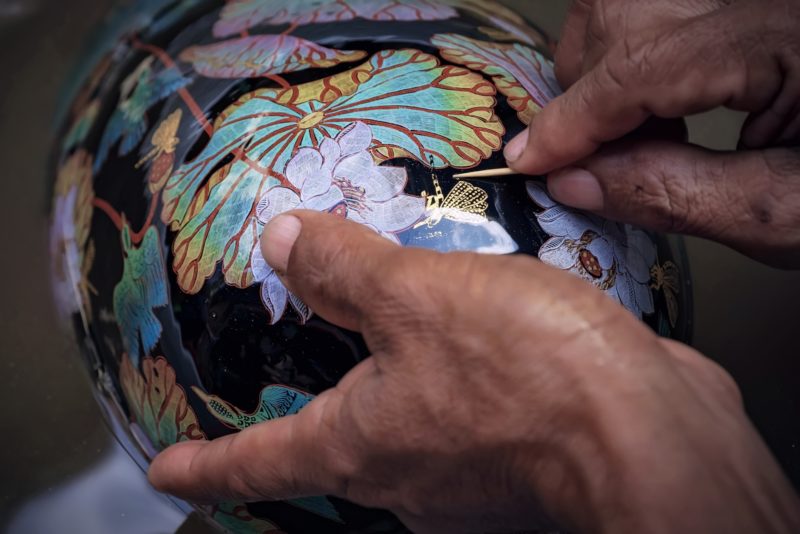

This was a lovely read! I want pictures of some of that lacquerware, my goodness.
—————–
What values you see in the game, and how they are reflected in the choices made by the game designer (This is what we’ll grade you, the reviewer, on for this “Values at Play” assignment.)
Tension between, if not filial piety exactly, at least respect for your family’s explicit wishes – and providing for the day to day – versus honoring tradition and craft.
How art is valued in society – i.e., TeleArts only honoring the protagonist’s grandmother after she’s dead (not that the patronage is nothing!). Helps build on the tension between saying that you value art versus materially supporting it, and further explores the tensions inherent to making art while also trying to make a living.
Talking to the different funeral attendees, and getting a sense of their own personal opinions, and relationship to Telearts, your grandmother, and art in general also helped to complicate this picture, and really flesh out the nuance therein. Having the conversations with your grandmother’s friend and the man in gold, in particular, were a good way of making the various tensions feel more material and explicit.
More broadly, the game set up different value systems, and explored how they related to art. Is art valuable because it can be sold? How do you value more people seeing your art, if that means giving up creative control? How can you evaluate the original intent of the artist? It felt particularly relevant, given everything going on with NFTs etc. at the moment.
I think the final choice, and the description of what happens after you make it, really helped to flesh out these tensions.
Thoughts on your experience relevant to the objectives in the rubric:
How well did the game get you to care about the given topic or cause?
Very well. It got me invested in the character and her grandmother, as well as her various relatives. It never felt didactic, which helped make the final choice itself feel genuinely complicated and affecting.
How well did the game’s use of the medium fit the story?
I thought it fit well. I think that there could have been a few more breaks in the text – i.e., splitting up dialogue across multiple lines, or adding more prompts to continue – but I also didn’t mind the long stretches of text. It ended up making it feel like the initial dream sequence was a bit disconnected from the actual ceremony, since the form differed, which I actually really liked, and thought worked well.
Did it have choices that were interesting and consequential to you? (Did any make you really stop and think?)
I liked that the decisions were foreshadowed – and presented in a nuanced way – as you approached the ceremony. Being aware of the possible choices I’d have to make meant that when that choice finally did come, I’d already invested a lot into thinking about it. It helped it feel more like it was the culmination of the story as a whole.
The other ones didn’t feel as consequential, but I think that actually worked very well. The rest of the story, and various conversations, were all necessary to set up that last choice, and I don’t think it needed other big decisions. It fit the scale of the story really well, and was genuinely difficult, which I think reflected the complexity of the types of values the game was dealing with very well.
Things I liked
I loved the atmosphere in the opening sequence, at the studio. It was really evocative, and set the scene wonderfully. I want to visit a cozy studio like that!
All in all was very well-written. Even though we didn’t spend that much time with any of her interlocutors, they still felt very deftly realized (i.e., the man dressing in gold at a funeral alone told so much about who he was as a person) and they really worked very well. It felt like a complex, lovely little short story.
I also liked the little hints at the world as a whole – things like the ‘outercity’ and ‘neighboring outercities’, or the ‘Resolutor’ title all really helped contribute to the suggestion that there was a complex, larger world out there.
Things to improve
There were a couple little typos, and it might have been good to separate more of the long passages into multiple ones. Very small changes, basically!
Effectiveness:
– Great motivation—love that you used this project to learn more about a traditional art form and culture! I also like that your story has a clear focus rather instead of jumping all over the place
– Your imagery is very effective—helps the player feel like they’re in the studio
– Good detail on the main character and the pressures she’s facing—helps with empathy
– Also, love how you describe the lacquerware pieces on display and the techniques used to create them
– Love the heartfelt dialogue from the grandmother and her friend
Playtesting:
– Give another run-through for typos if you want this to be your final project
Consequences:
– Very clear, impactful. Love the 3 concrete choices and their conseqences at the end
Honoring the Medium:
– Nice use of medium/transitions
– Might be fun to add more color for future iterations!
Documentation:
– Love the imagery and detailed documentation!